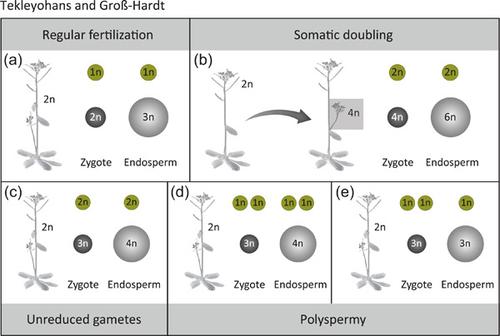当前位置:
X-MOL 学术
›
Mol. Reprod. Dev.
›
论文详情
Our official English website, www.x-mol.net, welcomes your feedback! (Note: you will need to create a separate account there.)
New advances and future directions in plant polyspermy.
Molecular Reproduction and Development ( IF 2.5 ) Pub Date : 2019-09-12 , DOI: 10.1002/mrd.23261 Dawit G Tekleyohans 1 , Rita Groß-Hardt 1
Molecular Reproduction and Development ( IF 2.5 ) Pub Date : 2019-09-12 , DOI: 10.1002/mrd.23261 Dawit G Tekleyohans 1 , Rita Groß-Hardt 1
Affiliation

|
Plants have evolved a battery of mechanisms that potentially act as polyspermy barriers. Supernumerary sperm fusion to one egg cell has consequently long remained a hypothetical concept. The recent discovery that polyspermy in flowering plants is not lethal but generates viable triploid plants is a game changer affecting the field of developmental biology, evolution, and plant breeding. The establishment of protocols to artificially induce polyspermy together with the development of a high-throughput assay to identify and trace polyspermic events in planta now provide powerful tools to unravel mechanisms of polyspermy regulation. These achievements are likely to open new avenues for animal polyspermy research as well, where forward genetic approaches are hampered by the fatal outcome of supernumerary sperm fusion.
中文翻译:

植物多精子的新进展和未来方向。
植物已经进化出一系列可能充当多精子屏障的机制。因此,长期以来精子融合到一个卵细胞一直是一个假想的概念。最近发现开花植物中的多精子不是致死性的,但会产生可行的三倍体植物,这一发现改变了游戏的发展,影响了发育生物学,进化和植物育种领域。人为地诱导多精子的协议的建立以及高通量测定法的发展,以鉴定和追踪植物中的多精子事件,现在为阐明多精子调节机制提供了强大的工具。这些成就也可能为动物多精子研究开辟新的途径,在这里,向前的遗传方法受到精子融合数量的致命影响。
更新日期:2020-04-13
中文翻译:

植物多精子的新进展和未来方向。
植物已经进化出一系列可能充当多精子屏障的机制。因此,长期以来精子融合到一个卵细胞一直是一个假想的概念。最近发现开花植物中的多精子不是致死性的,但会产生可行的三倍体植物,这一发现改变了游戏的发展,影响了发育生物学,进化和植物育种领域。人为地诱导多精子的协议的建立以及高通量测定法的发展,以鉴定和追踪植物中的多精子事件,现在为阐明多精子调节机制提供了强大的工具。这些成就也可能为动物多精子研究开辟新的途径,在这里,向前的遗传方法受到精子融合数量的致命影响。



























 京公网安备 11010802027423号
京公网安备 11010802027423号